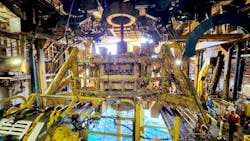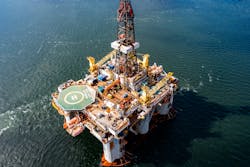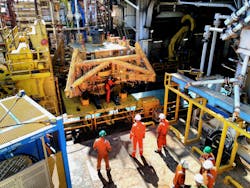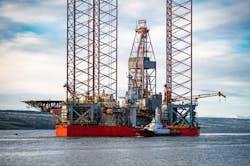P&A solutions provider builds team, rig fleet to take on North Sea wells
Editor's note: This story first appeared in the September/October 2023 issue of Offshore magazine. Click here to view the full issue.
By Jeremy Beckman, Editor, Europe
Six years after its formation, Well-Safe Solutions is emerging as the go-to provider of integrated P&A services in the North Sea region, with all three of its converted rigs in action for the first time this year on multi-well programs. The company continues to expand its toolkits for accessing legacy wells and its in-house engineering to support all aspects of the P&A campaign process, from front-end engineering design through execution. Now it is looking to extend this model to South-east Asia and Australasia and to adapt its service for future offshore carbon capture and storage projects.
Aberdeen-based Well-Safe claims to be the sole rig owner/operator and well engineering service provider anywhere dedicated exclusively to well P&A. Its’ well decommissioning delivery process is designed to guide operators each step of the way, with a gated project delivery plan. Through joining Well-Safe’s multi-operator P&A club, member companies can minimize their long-term costs through combining their well decommissioning scopes with those of other operators under rolling campaigns performed by Well-Safe’s rigs. They can also add wells to their roster and gain access at short notice to rigs or specialized decommissioning equipment should a need arise. Further cost benefits arise from access to a supply chain `package’ said to cover full P&A needs, instead of having to negotiate multiple contracts with different service providers
Well-Safe’s management includes individuals with experience of hundreds of wells worldwide acquired in previous roles with operators, service groups and drilling contractors. Chief Operating Officer Matt Jenkins previously headed well engineering and operations at ConocoPhillips UK, also leading development of the well decommissioning team for all the company’s UK North Sea projects. “When I left ConocoPhillips in 2017,” he recalls, “our most active area for P&A was a southern North Sea program, at the same time that Shell was decommissioning Brent in the far north. But generally in the North Sea it was then very much a case of individual operators doing their own work in isolation, not a large integrated program. Some years previously, when Hess were preparing to exit the UK North Sea they commissioned subsea P&A campaigns, but again, it was only Hess wells that were addressed because in that period there wasn’t a supply chain vehicle to bolt multiple operator multi-well campaigns together.
“One of the drivers for setting up Well-Safe was the experience of one of our peers which had a team established and delivering outstanding results for a P&A program. After it finished, the operator tried to find another opportunity within the wider North Sea to re-deploy the crew but there were none, so the team were disbanded and the learning curve lost. That was typical of the mind-set at the time. However, several of us believed there was scope for specialization: well P&A is not the same as drilling and E&P, the challenges and many of the tools required are different. Various others with the same views decided to leave their jobs to join Well-Safe.
“Well-Safe is a hybrid of an organization. We don’t have like for like competitors, rather we compete across several sectors, and P&A as a market remains in its infancy. A recent report suggested that only 9% of the UK’s offshore infrastructure had been decommissioned to date, so there is still a lot for the industry to learn.
“In the company’s first three years we worked very hard to sweep up the available expertise. We knew individuals who had learned lessons from P&A campaigns and we made a conscious effort to bring them into our organization to develop a center of excellence. Today we still do that but we now also grow our own, apprentices, school leavers, early professionals. On the basis that well decommissioning specialist do not grow on trees, the company offers offer a range of foundation, modern and graduate apprenticeships across the business in partnership with the Scottish Government’s Skills Development Scotland organization.
BUILDING A RIG FLEET, CAPABILITIES
“We looked at and screened every single available rig in the market,” Jenkins explains. “In operational terms we have internal expertise in running semis, platform rigs and jackups. Our specialists knew what areas of the rigs would need most investment. The reason we have our own rigs and modify them to suit our opportunities is that there are things we can do that you couldn’t if you rented an asset, it’s different from drilling.
“The whole drilling business and well construction has evolved as well design has changed. But the wells we decommission currently were put in during the 1970s and through the 1990s, which is also when these rigs were built. We don’t need newer, heavy-duty rigs: modern rigs have BOPs for higher pressure trees, and higher-spec equipment. Drilling continues to go deeper and further, with more complex mud and completion systems that require rigs with bigger decks and pit space. But for P&A we don’t need any of that functionality. For Well-Safe Defender, we identified a need to invest heavily in the mooring system as we move it around more than other rigs. With Well-Safe Guardian the focus has been on the moonpool where we run the trees and BOP, used far more than in drilling. There are other areas of rigs that you don’t need at all for P&A.
Well-Safe has an exclusive agreement with Trendsetter to deploy its Trident modular subsea well intervention system for decommissioning purposes in the UK on Well-Safe Guardian. Trident is designed to be set up quickly to provide downhole access for hydraulic, wireline and coiled tubing operations. Well-Safe Guardian also has a D300 15-person saturation dive spread and is said to be the sole semi in the North Sea with this capability: the equipment, manufactured and assembled at three ports in eastern Scotland, includes an electric bell-handling system and two hyperbaric lifeboats, and is engineered to provide safe access to subsea wellhead and Christmas tree systems installed from the 1970s onwards, which were designed for diver intervention. Its capabilities include manual tree removal, reconfiguration of hydraulic controls and flowline removal.
The Trendsetter equipment, dive spread and BOP will all be deployed for a nine-well P&A program for Repsol Sinopec Resources on the Buchan field. “There are numerous options for using these kits. No other semi in the UK has that capability to tackle complex legacy vertical wells that are found all over the North Sea, with no prior existing solution,” Jenkins claims.
LEARNING CURVES
“To cater for these unexpected situations the company performs a lot of peer reviews internally. Well-Safe has recruited multiple people with specialist experience in areas such as fishing, wellhead fatigue modeling, subsurface P&A design, wireline and perf/washing/cement operations. But every now and then the solution to a problem gets more bespoke: in that case we would organize a workshop with a service company that has done that task before. Recently we used technology developed in Norway and not previously deployed in the UK. We had a challenge cutting coil tubing out of a well the normal way so we collaborated with a specialist company in Norway, using their technology to cut the coil tubing 370 times into little lengths. Getting access to these people is helped by having multi-disciplinary teams. We employ abandonment engineers – not drilling engineers – for subsea intervention, fishing, milling and so on, all specialist skills.
“With every blip that we encounter, the feedback provided by the team has a positive effect in terms of future operational efficiency. Each year we are beating our own records: through turnkey execution, the rig moves are getting better and improving further as the teams become experts in these tasks.”
Building flexibility into campaigns extends to altering pre-agreed objectives if clients make extra requests, he adds. The most extensive P&A campaigns in the UK North Sea are typically on the larger and older fields. “There are certain relationships with clients under which Well-Safe can put forward one, two or all three rigs: depending on the work program they can select the appropriate facility.” Earlier this year the company signed a multi-framework agreement to decommission Apache Corp’s UK North Sea wells under its P&A Club arrangement. It gives Apache access to both Well-Safe Defender and Well-Safe Guardian with the flexibility to book work on any of the company’s wells as and when required. “It’s a fundamentally different model to what you normally find in the North Sea.
“With P&A, operators do want flexibility, as they may require different timing for different wells and fields for various reasons. That can mean six wells one year, 10 the next, but only one the following year. The UK’s North Sea Transition Authority’s stance is that amalgamating different operators’ P&A scopes into shared rig campaigns is valuable, as there is not an infinite timeline to execute work. And the Authority is prepared to be flexible around a company’s schedule: if an operator has a date agreed for abandonment in 2024, but a rig slot is not available until 2025-26, the Authority is receptive to deferral. What it is not receptive to is a delay for no good reason.”
In the UK the company has found that offshore operators have multiple different strategic approaches to decommissioning. “We are set up to suit all: some want to outsource everything, from planning to execution. Others just want one or two engineers: one had most of the staff needed, so just needed our team/rig to complete their capability. DNO, for instance, had two platforms where the program employed someone else’s jackup, and we executed that successfully.”
This year Well-Safe provided engineering support at bp’s Kate field, where the jackup Noble Innovator had been decommissioning two suspended wells. The work scope included determining subsurface isolation criteria, examining existing barriers and helping bp to optimize the barrier strategy. Now it has introduced Well-Safe Resources, headed by Steve Combe, through which the company will offer to support clients with outsourced engineering scopes. That includes incorporating its personnel into operator teams and providing customized P&A decommissioning assets where required.
Going forward Well-Safe will continue to bid for pure well decom work, Jenkins says. “We are very active in the UK and the Netherlands. Not at present in Norway: the market is not more difficult to break into, but there is nowhere near as much call for P&A work as in the UK. And there is a subtle difference in what you have to do with the wells at the end of their lives in both jurisdictions.” Elsewhere the company is providing consultancy services to clients in South-East Asia and well engineering in other countries such as Thailand, Indonesia, Australia, and New Zealand. “We can offer upfront engineering support potentially 10 years ahead, effectively a glide path to future decommissioning.”
As a launchpad for the region the company recently opened Well-Safe Solutions Pty based in Perth, Western Australia. “Although the operation is not purely Australia-focused our view is that the Australian market is of particular interest, with a very similar regulatory regime to what is in place in the North Sea. In many cases they take their lead technically from North Sea experiences, but they are four to six years behind the UK in decommissioning engineering where the process started six to seven years ago. And Australia is a very remote market with a large amount of widespread offshore assets. Having dedicated P&A rigs in South-east Asia is also a possibility. The value prospect of what we have deployed in the North Sea is just as applicable there, and Well-Safe has supportive shareholders that are keen to see the same solution rolled out in the region. In the UK the company has helped develop guidelines for P&A, and we will join some of the industry bodies in South-east Asia as the market evolves too in those countries.”
The company will also look to expand its in-house engineering offering. “We have a data analytics team in place, that will continue to grow, and subsurface design is another key area. We are very much of the belief that subsurface design married to well design for P&A is where a huge amount of value is added to execution - working with clients to challenge for instance where barriers go and why, what justification is there for more or less barriers to get an optimal design. Also, we will need subject matter experts as our workload grows in niche engineering such as fishing.”
Another emerging market for P&A is safe decommissioning of wells on fields that could be re-purposed for carbon capture utilization and storage projects. Well-Safe is working on two carbon capture well design projects in the UK offshore sector and has recruited a manager to lead work in this market. The company also contributes to work groups on P&A and subsurface design for CCUS, most led by the trade association Offshore Energies UK. “With CCUS wells, the aim is to directly abandon wells so that a field reservoir can be re-used followed by dedicated drilling of new wells. But there are complications, as most of wells to be isolated are designed for high pressures and temperatures whereas CCUS wells bring a combination of very low temperatures and very high pressures.”
Under a further in-house climate-related initiative, Well-Safe appointed UK consultancy PD&MS to review its operations to improve their sustainability. “We are looking to analyze everything that we do and areas where we could be more efficient, that could be hardware and engine changes or more efficient well practice. In P&A, rigs don’t use much engine power compared to drilling. So we are reviewing what we to optimize our rigs, including further modifications or changes to a project, to be more sustainable.”
About the Author
Jeremy Beckman
Editor, Europe
Jeremy Beckman has been Editor Europe, Offshore since 1992. Prior to joining Offshore he was a freelance journalist for eight years, working for a variety of electronics, computing and scientific journals in the UK. He regularly writes news columns on trends and events both in the NW Europe offshore region and globally. He also writes features on developments and technology in exploration and production.





